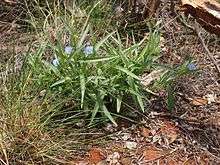Commelina ensifolia
| Commelina ensifolia | |
|---|---|
 | |
| Scientific classification | |
| Kingdom: | Plantae |
| (unranked): | Angiosperms |
| (unranked): | Monocots |
| (unranked): | Commelinids |
| Order: | Commelinales |
| Family: | Commelinaceae |
| Subfamily: | Commelinoideae |
| Tribe: | Commelineae |
| Genus: | Commelina |
| Species: | C. ensifolia |
| Binomial name | |
| Commelina ensifolia R.Br. | |
Commelina ensifolia, commonly known as scurvy weed, scurvy grass or wandering Jew,[1][2] is an annual herb native to Australia, India, and Sri Lanka.[3]
The species grows as a prostrate herb, producing roots from the stem at the nodes.[1] Flowers are bright blue with three petals, however one petal is much smaller than the others, often producing an appearance of two petals. The species prefers moist soils, but has a broad natural range, extending from coastal monsoon forest to the arid central deserts where it grows as an ephemeral following favourable rains.[1][2][4] The species has been eaten as a green vegetable by Aboriginals. European settlers also ate the plant to prevent scurvy, giving rise the common name of scurvy grass.[5]
The species is a minor weed in some parts of its natural range.[6]
References
- 1 2 3 "Commelina ensifolia". Australian Tropical Rainforest Plants. Retrieved 21 August 2014.
- 1 2 "Commelina ensifolia". Atlas of Living Australia. Retrieved 21 August 2014.
- ↑ Kew World Checklist of Selected Plant Families
- ↑ John Jessop; Australian Systematic Botany Society (1 January 1981). Flora of Central Australia. Reed.
- ↑ A. B. Cribb; Joan Winifred Cribb; Charles McCubbin (1987). Wild Food in Australia. Fontana/Collins. ISBN 978-0-00-636571-6.
- ↑ "Commelina ensifolia". Discover Nature at JCU. James Cook University Australia. Retrieved 21 August 2014.